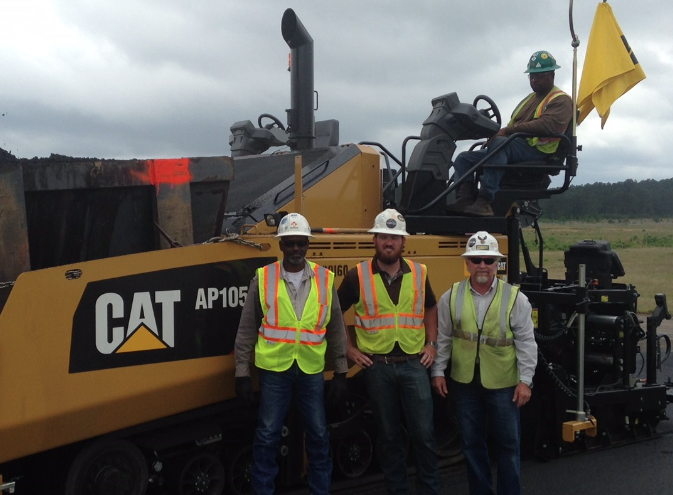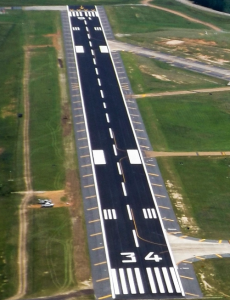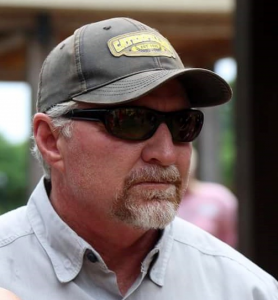Tarver Land Development Paves to Supports the Troops
BY Caterpillar

With 1,500 landings annually, Polk Army Airfield, located in Fort Polk, Louisiana, handles some heavy traffic. U.S. Army transport planes moving troops in and out of the base take their toll on the runway, which needed to be resurfaced after only five years.
Tarver Land Development, Alexandria, Louisiana, which also does pipeline and civil work at Fort Polk, completed the resurfacing project at the airfield.
Work began with a pair of 12-foot milling machines removing a 4-inch layer of asphalt from the existing 4,080-foot runway in four days. Although the runway was milled, shoulders remained intact. “The milling machines gave us a good canvas to go paint,” Donnie Givens said. He’s the Tarver Land Development operations director at Fort Polk.
After a test asphalt section was placed and approved by the U.S. Army Corps of Engineers, crews began placement of a 2-inch binder course and a 2-inch wear course.
While specifications called for a PG64-22 mix design, the contractor upgraded to a PG76-22 mix. The U.S. Army uses PG 64-22, a broad-spectrum mix design, for most asphalt work at Fort Polk.
“We went with the PG 76-22 mix because it is a stronger, more durable mix,” Givens said. “On this airstrip, they land a lot of large airplanes. We wanted to give them the best quality asphalt that we could. The mix helped make that happen.”
In the end, the runway yielded an IRI of 37.9 and a profile index average of 0.24, meeting the project smoothness specifications. Additionally, the overall mat density and joint specific densities had no failures.

Tarver Land Development won the 2015 Ray Brown Airport Pavement Award from the National Asphalt Pavement Association for the crew’s excellent work on the Polk Army Airfield resurfacing project.
The resurfacing was completed at such a high level of quality that Tarver Land Development earned the 2015 Ray Brown Airport Pavement Award from the National Asphalt Pavement Association.
Selecting the right mix for the job, a near-obsessive level of planning, excellent personnel, dedication to a continuous paving train, and top quality equipment all helped make the project a success. “This was one where all the stars aligned,” Givens said.
To help ensure a high quality overlay, Tarver Land Development set a self-imposed goal of not placing any transverse joints on the wear course. “On the second lift we went for two passes just to ensure that we didn’t leave any transverse joints,” CEO Jarred Tarver said. “We went from end-to-end. We knew that would give us the best quality project.”
Completing two passes, the crew placed approximately 1,200 to 1,260 tons daily. “Those are not big production numbers,” Givens said. “We were after quality, more than production. We didn’t have a single bump over the 1/8-inch bump spec. We’re proud of that.”
The use of a Cat® AP1055F paver with a Cat SE60 V XW vibratory screed helped the crew meet the specs. Cat Slope and Grade Control helped remove surface irregularities and control mat thickness.
“The IRI numbers say it all,” Givens said. “The milled surface was a 150.96 ride, and we had an IRI of 59.62 on the binder course. That’s a 60.5 percent improvement. That’s pretty large.”
An IRI of 37.9 was recorded on the 2-inch wear course. “From the milled surface to the wear course was a 74.9 percent improvement. That’s huge,” Givens said.
The screed’s standard hydraulic adjustment made it easy to pave at 12.5 feet wide on the wear course, and 16.6 feet wide on the binder course. The screed’s 8,973-pound weight helped it hold the angle of attack. “We didn’t have any density issues. We were looking for 92 on our joints and 95 on our mat,” Givens said.

Donnie Givens is the operations director at Tarver Land Development, Fort Polk.
Achieving those numbers required consistent asphalt flow. The use of a Weiler E2850 transfer vehicle helped regulate asphalt flow into the hopper.
Tarver Land Development synched its paving train with the asphalt plant to better achieve consistent asphalt flow. The plant was nine to 10 miles away, depending upon where the crew was working. Trucks were tarped to keep the mix hot on the trip to the site.
Planning helped keep trucks from stacking up, or large gaps in truck arrival from forming. “Not having a transverse joint is very tricky,” Givens said. “We planned two to three months in advance to make sure that we succeeded. We had prep meetings before we started every morning, so that everyone knew what our goal was that day. I was on the project all day, every day.”
Crew access to the base was limited to two gates and daylight hours. “We had a timeline of 7 am to 6 pm,” Givens said. “We were lined up, waiting at the gate in the morning. As soon as we were allowed to enter, we’d hop on and give it heck.”
The project began on March 27 and had to be finished by May 1. “Timelines at military bases are tight,” Givens said.
In the end, the runway yielded an IRI of 37.9 and a profile index average of 0.24, meeting the project smoothness specifications. The overall mat density and joint specific densities had no failures.
“We feel we planned well, and the team executed excellently,” Givens said. “We couldn’t have executed any better. It was one of the best teams that we could have put together.”
The Polk Army Airfield project demonstrates to current and potential customers the caliber of asphalt paving that Tarver Land Development is capable of producing.
“We want to duplicate that success. We want to achieve that type of quality again and again. It gives us repeat business,” Givens said.
And troop transport planes taking off and landing at Polk Army Airfield should have a smooth runway for years to come.
